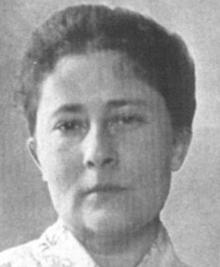| Augusta de Wit | |
|---|---|
 Augusta de Wit, from her 1898 book, Facts and Fancies about Java Augusta de Wit, from her 1898 book, Facts and Fancies about Java | |
| Born | Anna Augusta Henriette de Wit (1864-11-25)25 November 1864 Sibolga, Sumatra, Dutch East Indies |
| Died | 9 February 1939(1939-02-09) (aged 74) Baarn, Netherlands |
| Other names | G. W. Sylvius |
| Occupation(s) | Writer, educator |
Augusta de Wit (25 November 1864 – 9 February 1939) was a Dutch writer, born in the Dutch East Indies and best known for writing about Java.
Early life
Anna Augusta Henriette de Wit was born in Sibolga, Sumatra, the daughter of Jan Karel de Wit (1819-1884), a colonial official who served as Dutch Consul in Japan, and Anna Maria Johanna de la Couture (1837-1895). She had sisters Louise and Caroline, and brother Karel. She was educated in Utrecht and in England.
Career
Augusta de Wit began her career as a teacher at her alma mater, a girls' school in Utrecht. She returned to the East Indies in 1894, and taught at a girls' school in Batavia. For health reasons she left the classroom and became a writer, contributing to the Straits Times beginning in 1896. She published a collection of her articles as an illustrated book, Facts and Fancies about Java (1898), noting that "Hollanders do not understand the Javanese, nor do the Javanese understand the Hollanders, in any true sense of the word."
Further books followed, including the novel Orpheus in de Dessa (1903), Island-India (1923), and De wijdere wereld (1930). She also wrote short stories, and corresponded with D. H. Lawrence about translating his works into Dutch. As literary critic at the Nieuwe Rotterdamsche Courant, de Wit admired the work of Edith Wharton.
Personal life
Augusta de Wit was ill for several years before she died in 1939, aged 74 years, in Baarn. "She ranked among such authors as De Meester [nl], Coenen [nl], and Robbers [nl] and was a writer of temperate realism with an Oriental touch," recalled the New York Times in a brief obituary note. In recent years, her work is usually mentioned in the context of women writers and Dutch colonialism.
References
- Bel, Jacqueline; Vaessens, Thomas (2010). Schrijvende vrouwen: een kleine literatuurgeschiedenis van de Lage Landen, 1880-2010 (in Dutch). Amsterdam University Press. p. 35. ISBN 978-90-8964-216-5.
- "Miss De Wit's Book". The Straits Times. 31 May 1898. Retrieved 2020-10-23 – via NewspapersSG.
- Low, Eunice (2016-08-15). The George Hicks Collection at the National Library, Singapore: An Annotated Bibliography of Selected Works. BRILL. pp. 202–215. ISBN 978-90-04-32399-5.
- de Wit, Augusta (1898). "Facts and fancies about Java". DBNL (in Dutch). Retrieved 2020-10-22.
- Wit, Augusta de (1905). Java, Facts and Fancies. Chapman & Hall, Limited. ISBN 978-1-4655-8407-6.
- Low, Eunice (2016-08-15). The George Hicks Collection at the National Library, Singapore: An Annotated Bibliography of Selected Works. BRILL. ISBN 978-90-04-32399-5.
- Wit, Augusta de (1919). Orpheus in de dessa (in Dutch). Van Kampen.
- Wit, Augusta de (1923). Island-India. Yale University Press.
- Lawrence, D. H. (2002-11-28). The Letters of D. H. Lawrence. Cambridge University Press. p. 21. ISBN 978-0-521-00700-9.
- Werf, Els van der (2014). "Edith Wharton in Dutch Translation". Edith Wharton Review. 30 (2): 20. ISSN 2330-3964. JSTOR 10.5325/editwharrevi.30.2.0016.
- "Augusta de Wit" New York Times (11 February 1939): 19. via ProQuest.
- Beekman, E. M. (1982). "Dutch Colonial Literature: Romanticism in the Tropics". Indonesia. 34 (34): 17–39. doi:10.2307/3350946. hdl:1813/53750. ISSN 0019-7289. JSTOR 3350946.
- Groot, Marjan (June 2015). "Inscribing women and gender into histories and reception of design, crafts, and decorative arts of small-scale non-European cultures". Journal of Art Historiography. 12: 1–32 – via ProQuest.
- De Mul, Sarah (2011). Colonial Memory: Contemporary Women's Travel Writing in Britain and the Netherlands. Amsterdam University Press. p. 42. ISBN 978-90-8964-293-6. JSTOR j.ctt45kdr7.
External links
- Works by Augusta de Wit at LibriVox (public domain audiobooks)

- "Balinese Girl in Temple Costume" published by Augusta de Wit, in the Nationaal Museum van Wereldculturen, Amsterdam.